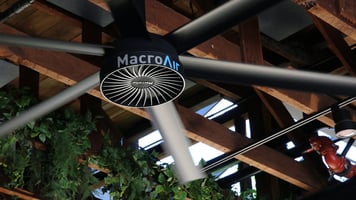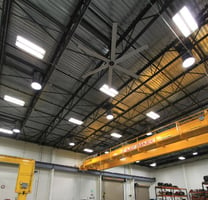High-volume, low-speed (HVLS) fans are extremely popular; they can be found in warehouses, gyms,...
How Much Does a Large Industrial Ceiling Fan Cost?
“How much do HVLS fans cost?” Naturally, you’ve heard all the benefits of HVLS fans, how they provide incredible air movement, are energy efficient, are nearly silent, and give you floor to ceiling air circulation. If you are looking for pricing for MacroAir Fans, make sure to visit our online shop. But, to know the exact HVLS fan price, you must consider your needs and the size of the industrial ceiling fan you choose. In this blog, you will find general pricing guidelines and some additional add-ons to consider when determining the general cost of HVLS ceiling fans. A major part of the decision-making for most of our customers is energy costs, and we’ll cover that also.
The options of purchasing an HVLS fan may seem daunting as a number of competitors have entered the space. But have no fear, we invented these types of fans and are continuously innovating.
Whatever your purchasing goals are, staying within a certain upfront cost will help you narrow down your choices. It’s also important to note the potential cooling and heating savings with an HVLS fan vs air conditioning and traditional heating. You can lower your electricity bills by over 50% just by utilizing our fans vs continuously relying on HVAC systems.
Note that due to their sheer size and customization, there are lots of options to make a fan fit your needs. Those options are listed below:
OPTIONAL LARGE INDUSTRIAL FAN ADD-ON FEATURES
- Installation labor cost
- Possible installation infrastructure support
- Custom blade anodizing
- Custom extensions
- Corrosion-resistant coating
- UL control panels
- Warranties
- Maintenance package
- Custom powder coating
- Environmental Specifications (ex: explosion-proof, FDA compliant, washdown applications)
7 LITTLE KNOWN FACTORS THAT COULD AFFECT THE PRICE OF YOUR INDUSTRIAL CEILING FAN
1. FAN SIZE:
The cost of a large ceiling fan at MSRP is generally between $3,000 – $9,000. Generally, the size of the fan is what determines the price of a fan. An 8-foot industrial ceiling fan will be at the lower end of the price spectrum, while a 24-foot industrial ceiling fan will be at the high end of the price spectrum.
The larger an HVLS fan is, the more power it has to push air down. Determine HVLS size by two things: the size of the room and the height of its ceiling. For smaller spaces with common ceiling heights of between 8′ and 12′, a 6′ or 12′ HVLS fan is usually best. For larger spaces, an HVLS fan of up to 24′ will work better.
In addition to size, the price varies depending on the manufacturer, model, and features included with the purchase. Typically, a complete industrial ceiling fan purchase includes a motor unit, blades, motor control panel, motor control cable, remote cable, and remote.
2. SHIPPING COST:
The fans are big and can weigh anywhere from 213 pounds to over 400 pounds. Because of their massive proportions, the cost to ship the fans is often not included in the purchase. Shipping for medium to large ceiling fans typically ranges around $200 depending on the fuel surcharge.
3. INSTALLATION COST:
Some may think fan installation is an area they can cut costs and save money, but, in reality, this is an area where paying more for good service is well worth it. According to industry experts, a poorly installed fan can lead to inefficient cooling and increased use of power, two things that will raise the cost of your fan.
Professional installation is needed by either your maintenance team (1-2 people) depending on the brand you purchase or an installer of your choice. Some industrial ceiling fan manufacturers will require a factory installation otherwise the warranty would be void. The particular installation scenario determines the installation cost. Some of the largest and heaviest ceiling fans may require infrastructure installation support.
Different large ceiling fan manufacturers have different options for installation that affect the price. Working with a large industrial ceiling fan manufacturer who uses a full-service distributor means that the distributor will assist you through the sales process, personally handle the installation, and/or be the installer of your industrial ceiling fan. Not all manufacturers and regions have full-service distributors. However, there are alternative options such as purchasing directly from the manufacturer and self-installing or having a factory installation done. Each option offers different costs and benefits.
4. HARDWARE COST:
Most large industrial ceiling fans require 38-96 inches of clearance from the ceiling. To allow for this clearance, guy wires are typically needed at installation. In addition to the guy wires, industrial ceiling fans need installation hardware prescribed by the mounting solution that you decide upon.
5. WARRANTY COST:
Most large industrial ceiling fan manufacturers will offer a warranty on their fans. The length of coverage varies according to each individual manufacturer. A typical warranty range is 2-15 years. A longer warranty can save you a substantial sum over the life of a fan because you will pay less for repairs if something goes wrong. Even if two fans are equal in upfront cost, the fan with the better warranty will actually cost you less in the long run. A long warranty is a sign that a manufacturer is confident in their products; a shorter warranty, on the other hand, should raise some questions. Here is MacroAir’s Warranty Information.
6. ANODIZED BLADES COST:
Anodized blades help prevent corrosion. Some large industrial ceiling fan manufacturers anodize the blades on all their fans and some offer this as an add-on feature.
7. AIR EXCHANGE RATE:
HVLS fans work by moving air around, a process that creates a small amount of negative pressure in a room. The air exchange rate, otherwise known as air change rate (abbreviated ACH or ac/h), measures this process. In general, fans with a higher ACH rate will usually cost more.
HOW EXACTLY IS AIR EXCHANGE MEASURED?
It’s a scientific process, but it involves the use of tracer gases that are not naturally present in a room. The concentration of these tracer gases is then measured after the fan has been used for a period of time, which indicates how much air the fan can move. Since rising hot air can often be hot enough to overpower the cool air pushed down by the fan, our fan must have an air exchange rate that is high enough to effectively cool the room it’s installed in. And remember, fans with a higher ACH rate will usually cost more.
SUMMARY:
Although these price guidelines are general and vary according to your particular cooling needs, they should hopefully give you a better understanding of the total cost when purchasing industrial HVLS fans.
Different manufacturers offer different initial MSRP pricing. It is important to factor in all of the additional costs involved in purchasing, shipping, and installing a large industrial ceiling fan when planning your purchase. And on the plus side, remember to account for the energy consumption and huge potential energy savings when making your purchase decision. You will be much more prepared when making your purchase decision if you come informed and educated on these costs and benefits.
Visit our shop today to see our beautiful line of HVLS fans and MSRP pricing.
Did our HVLS fan price guidelines help? Leave your comments below.


